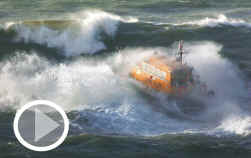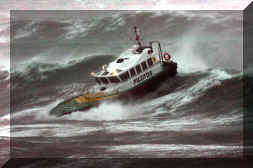| WILDCAT
40 / 12m CATAMARAN ENGINEERING
|
|||||
|
SPECIFICATION
L.O.A. Length Moulded BEAM Beam moulded Draft Displacment Lightship Seating capacity Fuel capacity Engines Power output Gearboxes Generator Speed Operational Maximum Certification
WLDCAT 40, Ocean Ranger in force 8 and breaking seas
Rough weather video of La Reunion Wildcat in big waves
WLDCAT 40, Seaflower Rough weather trials, force 7-8 off Cork, Ireland
WLDCAT 40, MISBEHAVIN. Rough weather video, twin boat, force 7-8
WLDCAT 40, BLACK cat. Rough weather trials, force 7-8 off Cork, Ireland
|
40ft / 12m 11.8m 4.9m 4.8m 1.3m
12,000-14,000kg 12 pass / 3 crew 1000 litres Volvo /Cat/Yanmar 250 - 500hp Twin Disc 5126 9kw
16-25kts 30kts+ MCA Bureau Veritas |
Safehaven's depth of engineering expertise is demonstrated by our Multi Beam deployment system The advantage of a catamaran when designing a deployment system for the expensive multi beam sonar head is that by deploying the sonar head through a moon pool in the catamarans bridge deck, a high degree of protection is provided by the twin hulls. The system is designed to lower the sonar head mounted on a 4m aerofoil design support to just below the vessels keel, operation is through a 2m stroke stainless steel cylinder with electro hydraulic operation mounted on the back of the wheelhouse on the aft deck, which lowers the head through a hatch integrated into the bridge deck forming a ‘moon pool’ the sonar head then extends down to below the keel line whereby sonar data can be collected at low speeds. For fast transit speeds the sonar head is raised and the moon pool hatch closed, whereby the vessel can again operate at high speed with the sonar head safely protected.
It is anticipated that the multibeam system to be fitted to the vessel will be either a Kongsberg 3002 or a Reson 8125, The system will be chosen for the engineering capabilities. The
sonar will be mounted as close to the centre of gravity as possible.
Ducting will be provided for the cable to the survey position. The
diameter of this cable will depend on the chosen system, and an
allowance will be made for this in the design. The sonar will therefore
be mounted solidly to the hull. This will allow a minimum amount of flex
between the systems employed on the vessel, to ensure the accuracy of
the measured depth. Inertia Motion Sensor
It
is anticipated that an Applanix POSMV inertial aided motion unit will be
used to correct for the motion of the vessel. A mounting plate will be
fabricate for the unit. The
IMU will be mounted above the multibeam transducer Dual Frequency Single Beam Echo Sounder
The
anticipated preferred survey specification echo sounder for the vessel
is the dual frequency Reson Navisound 420 and associated transducer.
Ducting for the cable to the survey location will be provided. The
survey echo sounder will be used as part of the navigation requirements
using a repeater at the helm station. A large range of engines are possible, from 250hp up to 500 hp to provide speeds from 22kts up to 30kts TS Dip and Deck Equipment/Sensors
It is anticipated that
a TS Dip and additional survey systems, such as side-scan sonar will be
used. There can be porovided a safe system of deploying the TS dip and
the additional survey systems via a transom mounted ‘A’ frame
outlined elsewhere.
Design features. The benefits of the
catamaran hull form are: Transverse static
stability, less rolling and motion Directional stability
in following sea conditions Lower vertical
accelerations smother motion in choppy head seas Lower power
requirements Greater economical
operational range Deck area Cabin space
Safehaven Marine, Ashgrove, Cobh, Co Cork, Ireland Phone 00353 86 8054582 Email- info@safehavenmarine.com safehavenmarine@eircom.net
|
All our vessels are build to the highest standards of strength & engineering and are renowned world wide for their exceptional sea keeping abilities. For the best, most extreme, rough weather demonstration videos of our boats, see our amazing selection on you tube.
BEST ROUGH WEATHER ACTION PHOTOS We don't just claim our boats have the best sea keeping abilities, here's the proof |
||




